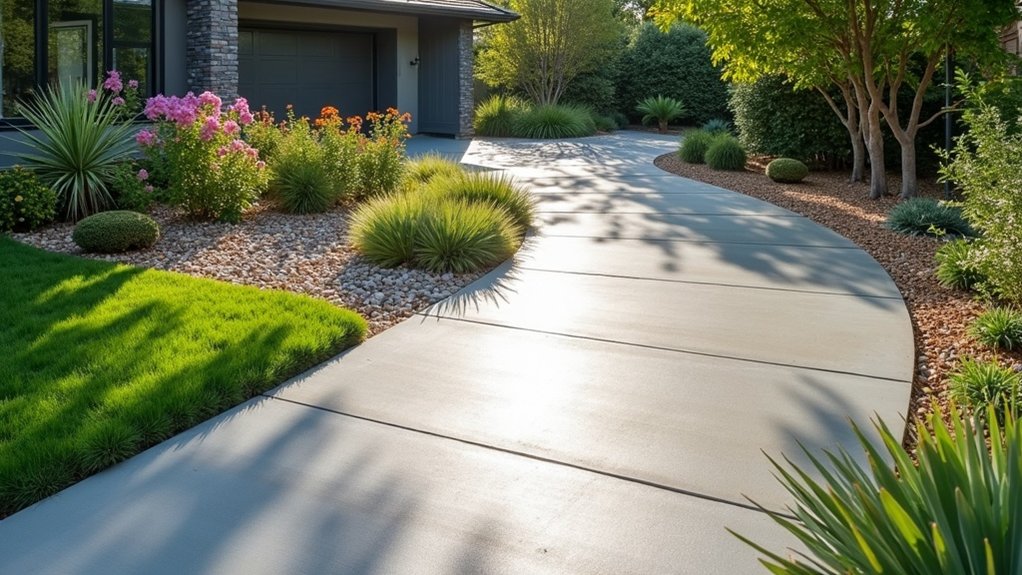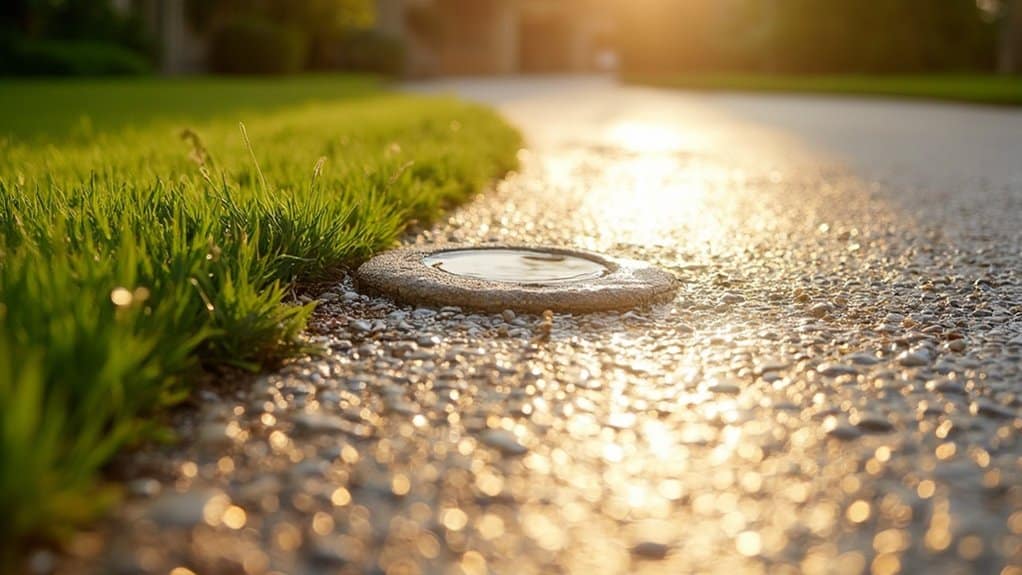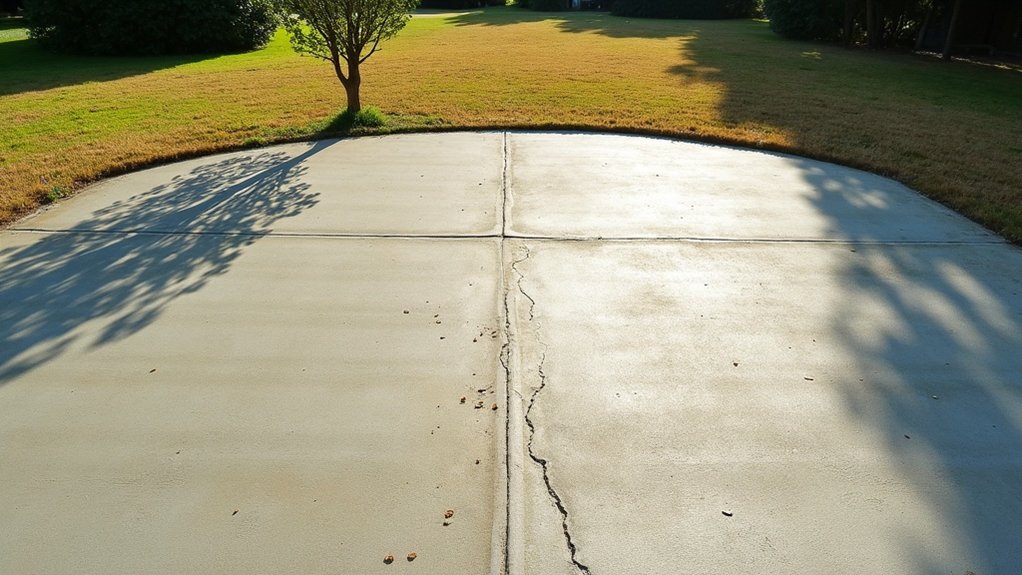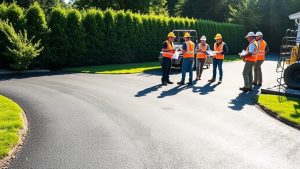Concrete driveways have a notable environmental impact, accounting for around 8% of global CO2 emissions. While their durability is a plus—reducing the need for frequent replacements—they can also contribute to urban heat and increase stormwater runoff.
Sustainable alternatives, such as permeable paving and gravel driveways, offer better water management and can lower your carbon footprint. When choosing a driveway, it’s important to weigh these factors. Innovations in eco-friendly materials are continually emerging, making it easier to find a greener option that suits your needs.
Table of Contents
ToggleKey Takeaways
- Concrete driveways are a notable source of CO2 emissions, making them less environmentally friendly than other options.
- When installed correctly, concrete can last for decades, which reduces the need for frequent replacements and conserves resources over time.
- Conventional concrete contributes to the Urban Heat Island effect and can strain stormwater systems, leading to various environmental concerns.
- Eco-friendly alternatives, such as permeable paving and gravel driveways, effectively manage stormwater and typically have a smaller carbon footprint.
- Recycling concrete from demolished buildings supports a circular economy by conserving resources and minimising landfill waste.
The Carbon Footprint of Concrete Production
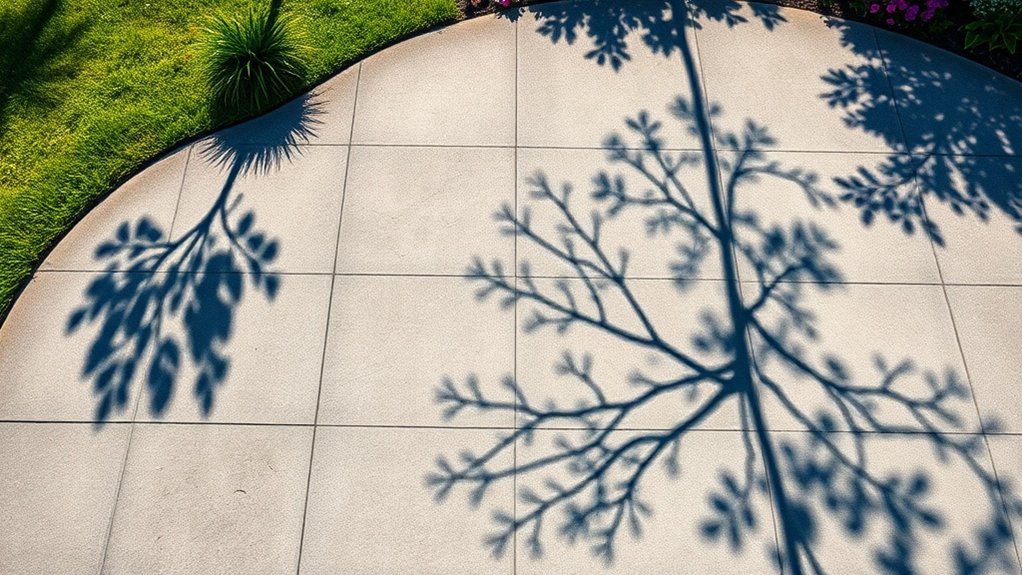
Concrete is one of the most commonly used materials globally, yet its production significantly contributes to carbon emissions, accounting for around 8% of total CO2 emissions.
In 2023, cement manufacturing alone released about 1.56 billion metric tons of CO2, mainly due to the processes of calcination and fuel combustion. As urban development grows, emissions are expected to rise sharply unless we change our practices. The concrete industry is responsible for over 4 billion tons of carbon emissions each year, highlighting the urgent need for sustainable practices.
Fortunately, there are emerging sustainable solutions. Innovations such as low-carbon cements and reducing clinker ratios are steps towards minimising the carbon footprint.
Additionally, methods like carbon capture and recycling concrete materials provide effective ways to cut emissions, helping us move towards a more environmentally friendly approach to concrete production.
Durability and Longevity of Concrete Driveways
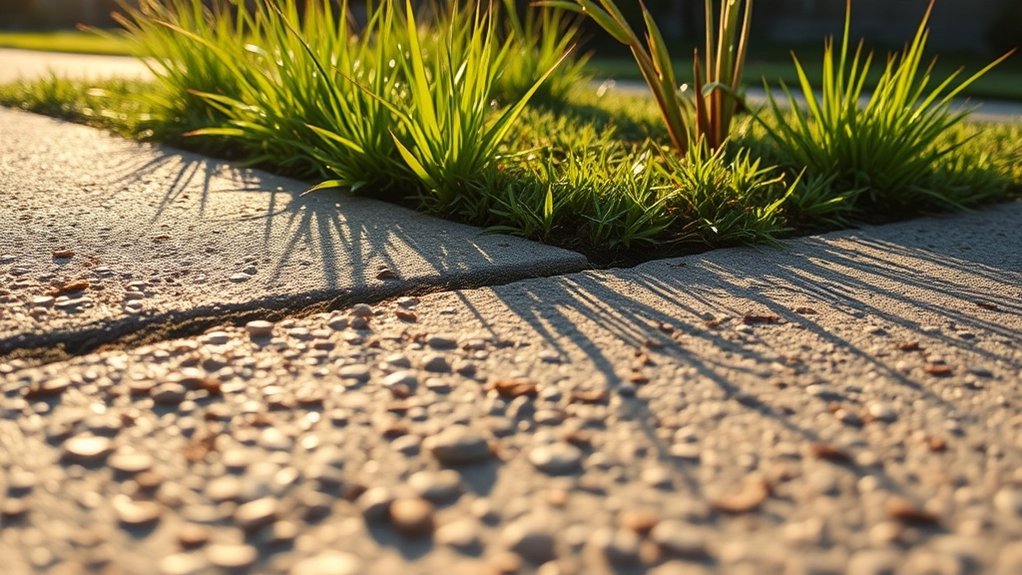
As the concrete industry aims to lessen its environmental footprint, grasping the durability and longevity of concrete driveways is essential. A properly installed concrete driveway can typically last between 25 to 30 years, with some exceptional cases lasting over 50 years. However, this lifespan hinges on effective installation and ongoing maintenance.
For instance, proper site preparation, such as a well-compacted subbase and reinforcements like rebar, boosts the driveway’s strength. Regular upkeep, including cleaning, sealing every 2-5 years, and addressing cracks promptly, is vital for prolonging its life. Additionally, factors like weather and traffic can affect durability, highlighting the importance of using quality materials and professional expertise to ensure your investment endures. Therefore, proper maintenance can significantly extend the lifespan of your concrete driveway. Moreover, regular inspections can help identify potential issues early on, allowing for timely repairs that prevent further damage.
Environmental Impact of Concrete Installation
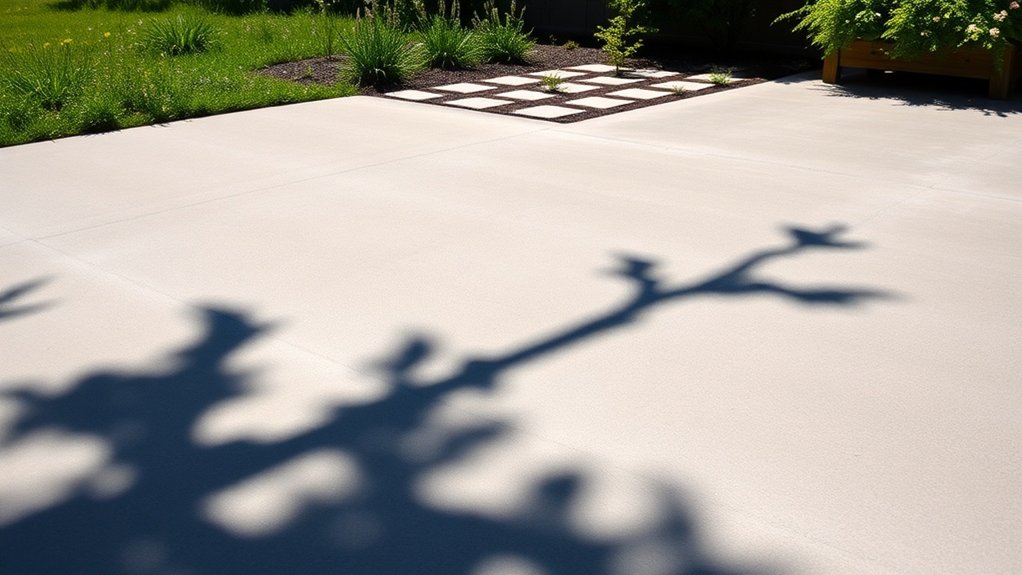
The environmental impact of concrete installation is considerable, mainly due to the high carbon emissions linked to cement production. Cement contributes to around 8% of global CO2 emissions, primarily from its energy-intensive manufacturing process.
When you factor in the energy used during installation and the potential disruption from resource extraction, several key environmental issues emerge:
- High energy consumption from machinery during pouring and curing
- Disruption of local ecosystems from sand and gravel extraction
- Significant water use in mixing and curing
- Difficulties in effectively recycling concrete waste. Additionally, the durability of surfaces means that while concrete has a longer lifespan, its initial environmental impact during production is significant.
Urban Heat Island Effects and Concrete
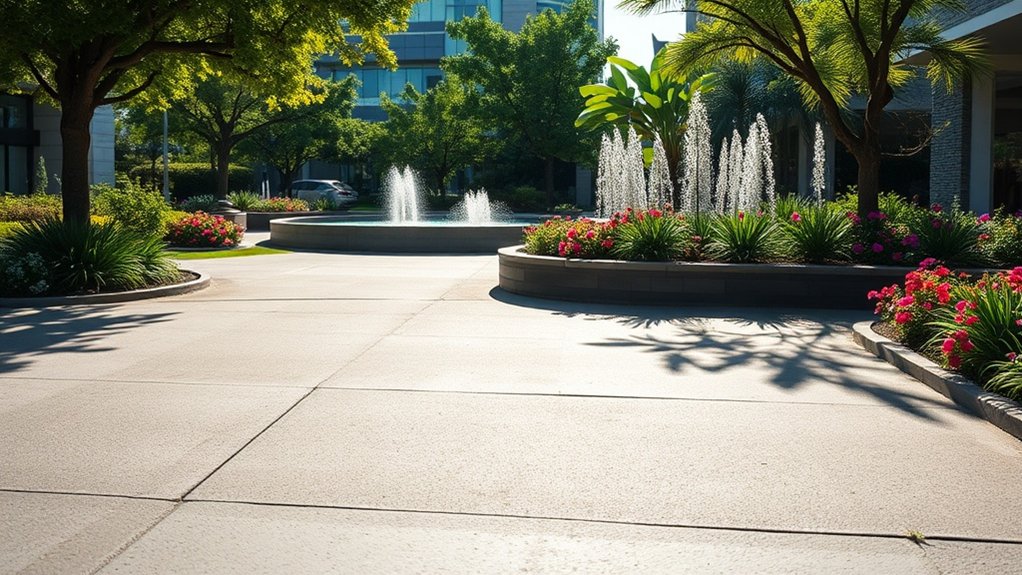
Concrete driveways are tough and practical, but they significantly contribute to the Urban Heat Island (UHI) effect.
Their low albedo and high thermal mass mean they absorb a lot of solar radiation, storing heat during the day and releasing it at night. This leads to warmer urban nights, making cities several degrees hotter than rural areas.
The absence of vegetation and the prevalence of hard surfaces limit natural cooling, worsening heat retention. As urban temperatures rise, the demand for cooling increases, which in turn raises greenhouse gas emissions.
To tackle these challenges, we should consider sustainable options like cool pavements or permeable concrete to help reduce UHI effects and improve urban living conditions.
Water Management With Concrete Surfaces
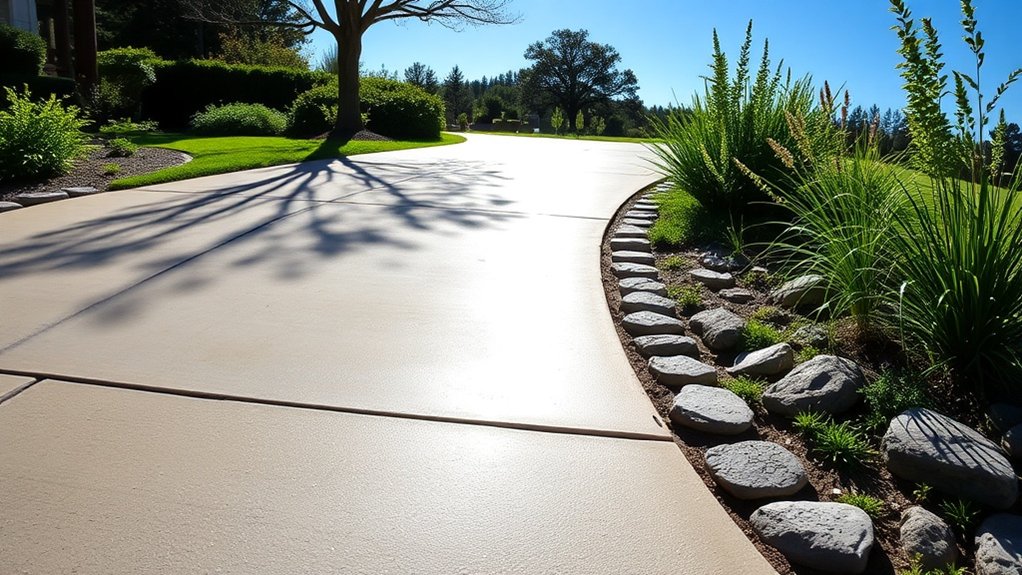
Managing stormwater runoff is crucial for preserving the condition of your concrete surfaces and the surrounding environment.
Consider solutions like permeable concrete and effective drainage systems. These options not only help reduce runoff but also promote groundwater recharge. Additionally, utilizing permeable driveways can enhance stormwater management while supporting local ecosystems.
By implementing sustainable drainage strategies, you can minimise erosion and protect your property from structural damage.
For instance, installing a rain garden can effectively manage excess water and enhance your landscape.
Stormwater Runoff Impact
Concrete driveways, while durable, significantly affect stormwater runoff due to their non-porous surface. This results in increased runoff volume, which can overwhelm drainage systems and lead to flooding. The runoff often carries pollutants that can seriously harm water quality. Therefore, effective management of this runoff is crucial.
- High runoff coefficients (up to 0.9) indicate that most rainfall becomes runoff.
- Runoff can transport sediments, heavy metals, and hydrocarbons into nearby waterways.
- The elevated temperatures of concrete runoff can contribute to thermal pollution.
- Implementing better stormwater management practices can enhance pollution control.
Understanding how concrete driveways influence stormwater is essential for developing sustainable solutions that safeguard our water resources.
Water Infiltration Solutions
As urban areas face ongoing challenges with stormwater management, exploring water infiltration solutions is crucial for addressing runoff issues linked to traditional concrete surfaces.
One effective method is the use of permeable surfaces, such as permeable concrete and TRUEGRID pavers. These materials allow rainwater to filter through, significantly reducing surface runoff.
Implementing drainage solutions like trench drains and French drains can further improve water management by efficiently collecting and redirecting excess water.
Additionally, incorporating gravel borders and optimising surface grading promotes natural infiltration, helping to prevent water pooling and flooding.
Sustainable Drainage Practices
Effective water management is crucial for preserving concrete surfaces. By adopting sustainable drainage solutions, you can significantly reduce runoff and improve water absorption.
Here are some eco-friendly drainage options to consider:
- Permeable surfaces such as permeable paving allow water to seep through, reducing surface pooling.
- Trench and channel drains help manage larger volumes of water, directing runoff away from your concrete areas.
- Swales are designed to filter runoff and encourage groundwater replenishment.
- Regular maintenance of drainage systems ensures they work efficiently, preventing erosion and structural issues.
These practices not only protect your driveway but also contribute to a healthier environment.
Embracing sustainable drainage will keep your concrete surfaces in excellent condition for years to come.
Energy Use in Concrete Manufacturing
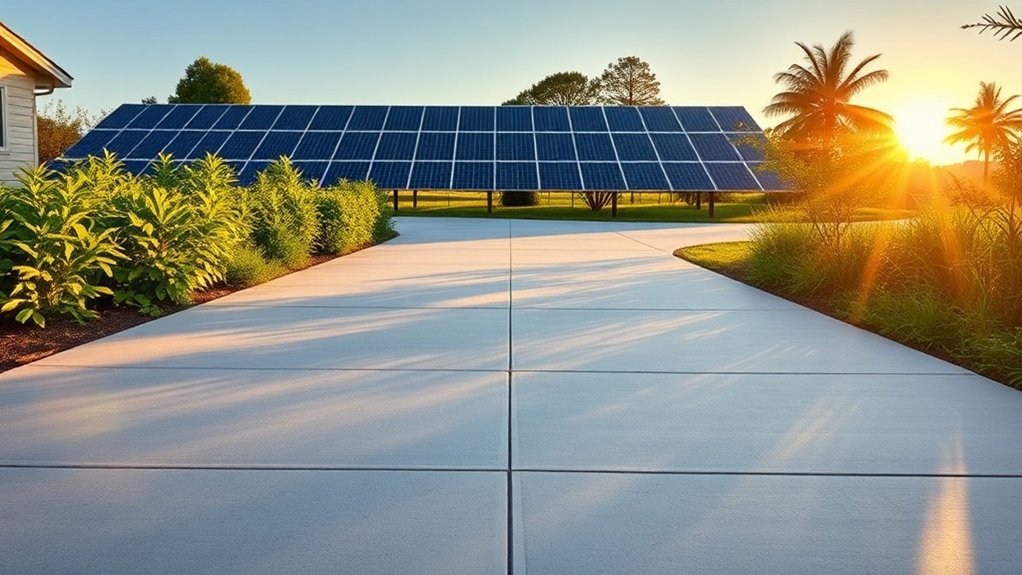
Energy use in concrete manufacturing significantly impacts the environment. Cement production is one of the most energy-intensive processes, responsible for about 3% of global energy consumption.
Traditionally reliant on fossil fuels, the industry is now shifting towards alternative fuel sources, with renewables comprising 16% of the UK’s fuel mix in 2023.
Advancements such as improved kiln designs and blended cements have reduced energy demand per tonne of cement. Moreover, innovations like waste heat recovery systems enhance efficiency even further.
As these developments progress, the cement industry can lower its carbon footprint, making concrete a more sustainable choice for your driveways and other projects.
Recyclability of Concrete and Its Benefits
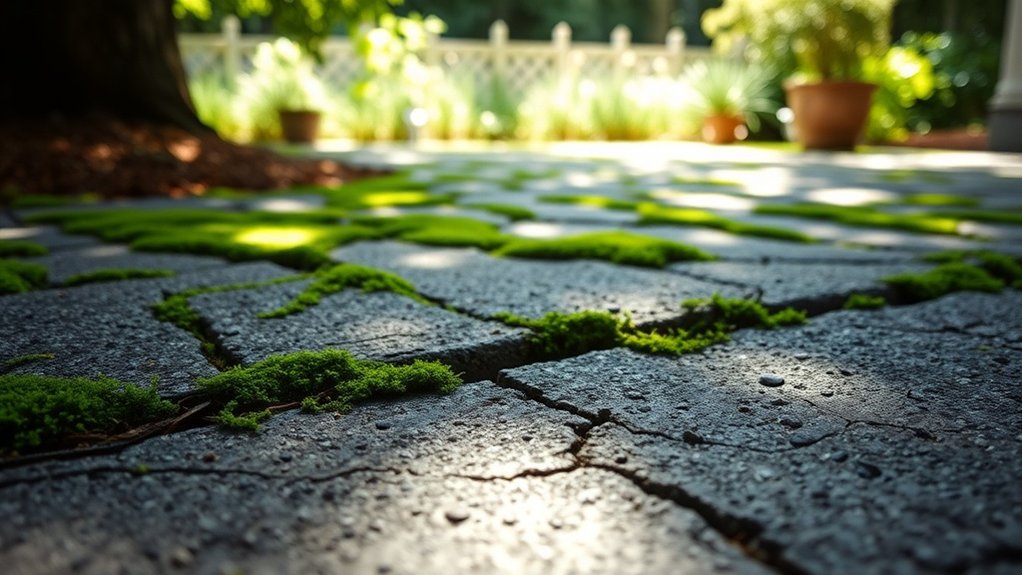
When considering concrete recycling, it’s important to grasp the process and its positive environmental impact.
Turning old concrete into recycled aggregate helps reduce landfill waste and conserves natural resources.
For instance, using recycled materials in new buildings promotes sustainable construction and lessens ecological disturbance.
Concrete Recycling Process
Concrete recycling is a vital process that turns waste from demolished buildings into useful materials for new construction.
It starts with the collection of concrete waste, which is then crushed and screened to remove contaminants. Innovative recycling technologies, such as Sika’s reCO2ver, improve the separation of cement and aggregates, supporting a circular economy.
Key steps in the concrete recycling process include:
- Efficient collection and processing of concrete waste
- Crushing, grinding, and screening to achieve the desired aggregate size
- Quality control testing to ensure materials are suitable for construction
- Separation of high-quality materials for enhanced performance
Environmental Impact Reduction
Recycling concrete significantly reduces environmental impact through its recyclability and associated benefits. By reusing concrete as aggregate in new mixes, we cut down on waste and lessen the need for raw materials, leading to notable environmental advantages.
This practice preserves natural resources and lowers the energy and emissions linked to obtaining new materials. Furthermore, using locally sourced materials reduces transportation emissions, promoting sustainability.
Incorporating recycled materials supports a circular economy, which is vital for sustainable construction. Concrete’s durability also means fewer repairs and replacements, conserving resources and energy in the long run.
Recycled Materials in Construction
Many construction materials harm the environment, but the recyclability of concrete presents a sustainable option for the industry.
Using recycled concrete aggregates (RCA) in your projects can significantly reduce reliance on natural coarse aggregates. This not only conserves resources but also provides similar strength across various applications.
- RCA is around 40% cheaper to produce than natural aggregates.
- It cuts CO₂ emissions by approximately 3.42 kg per m³ of concrete.
- Incorporating RCA can lower water usage by 4.36 m³ per m³ of concrete.
- The global market for recycled concrete is set to expand quickly, reflecting a rising demand for sustainable solutions.
Sustainable Practices in Concrete Production
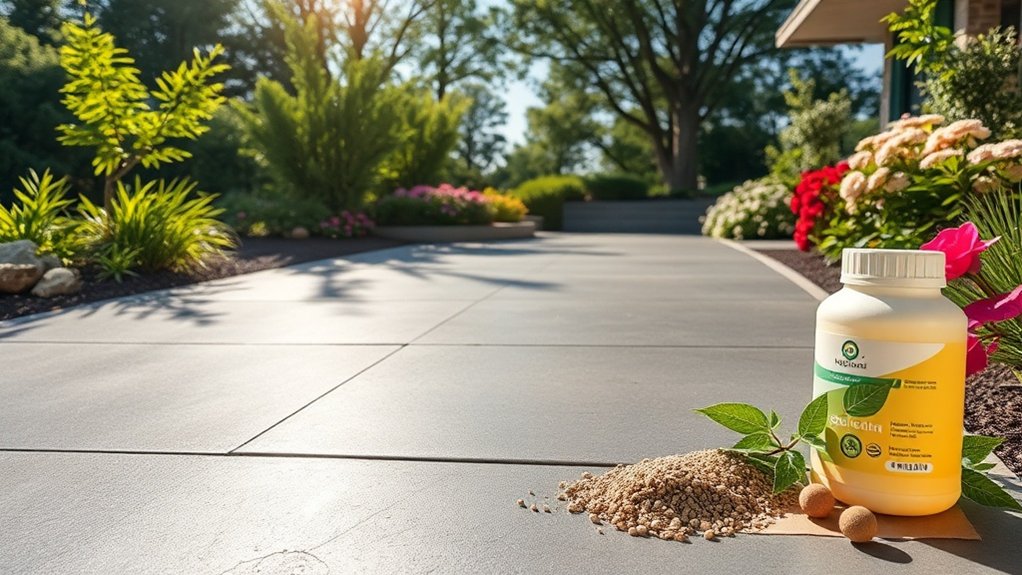
As the construction industry faces mounting pressure to reduce its carbon footprint, sustainable practices in concrete production are becoming essential for minimising environmental impacts.
One effective strategy is the use of supplementary cementitious materials (SCMs), which can significantly lower CO2 emissions by reducing the amount of clinker in concrete mixes.
Improving kiln efficiency and transitioning to renewable energy sources in cement production also help to decrease greenhouse gas emissions.
Additionally, implementing carbon capture technologies is crucial for tackling emissions generated during clinker production.
Alternatives to Traditional Concrete Driveways
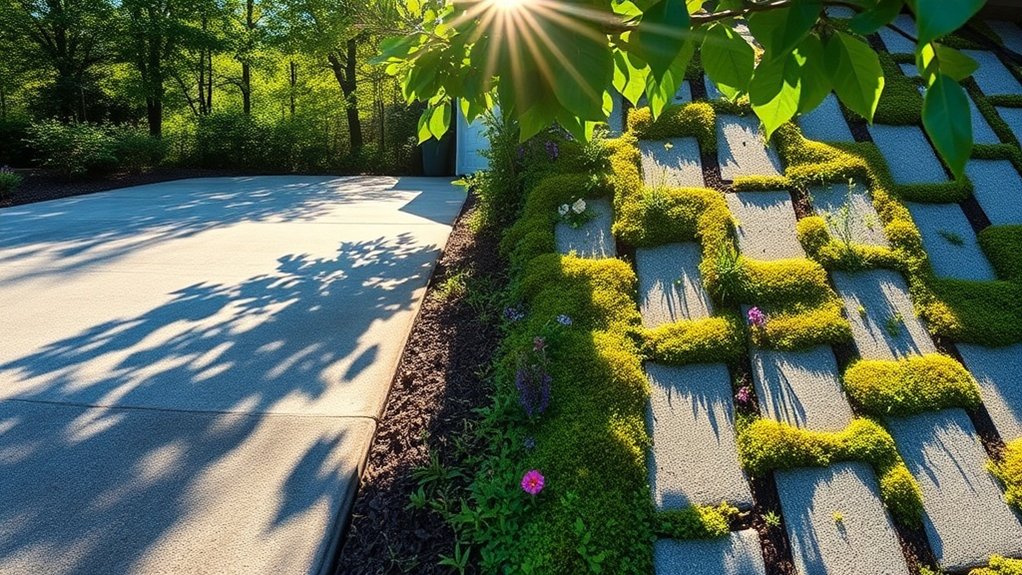
When exploring alternatives to traditional concrete driveways, permeable paving and green infrastructure options are worth considering for their environmental advantages. These materials help reduce surface water runoff, encourage groundwater recharge, and support local wildlife. Additionally, permeable materials like porous asphalt and gravel can enhance stormwater management while providing aesthetic appeal.
Permeable Paving Solutions
If you’re seeking sustainable alternatives to traditional concrete driveways, permeable paving solutions provide an eco-friendly option for managing stormwater runoff.
These systems use permeable materials that allow water to filter through, helping to reduce erosion and replenish groundwater.
- Permeable Plastic Grid Pavers: Constructed from recycled plastic, these are durable and low-maintenance.
- Permeable Concrete and Asphalt: Specially designed mixes that let water seep through into a stone base, improving drainage.
- Gravel Driveways with Defined Edges: Naturally permeable and cost-effective, though they require regular maintenance.
- Grass Pavers: Allow for vegetation growth, combining aesthetic appeal with effective stormwater management.
Green Infrastructure Options
While traditional concrete driveways are common, exploring green infrastructure options reveals sustainable alternatives that benefit the environment.
Wooden driveway pavers, especially those made from Black Locust, are durable and have a low carbon footprint.
Gravel driveways allow for natural water drainage, are cost-effective, and can last over a century with proper maintenance.
Recycled material grids and composite pavers use repurposed plastics, reducing landfill waste and enabling permeable surfaces.
Porous asphalt and concrete alternatives support aquifer recharge by filtering water.
Crushed seashell driveways and natural stone add unique aesthetics while promoting sustainable landscaping.
Choosing any of these options can significantly contribute to eco-friendly living.
Permeable Paving Solutions for Driveways
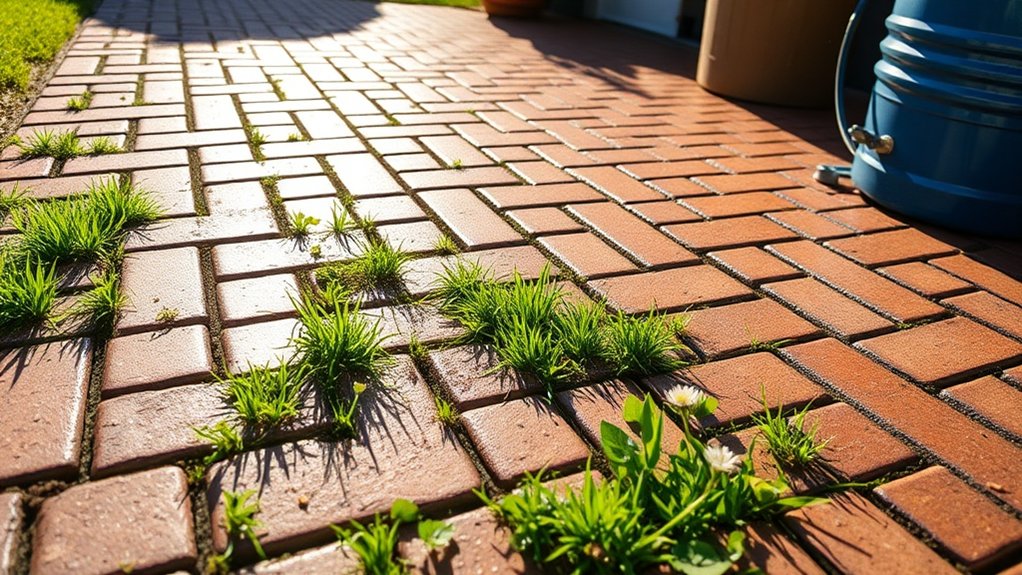
Permeable paving solutions for driveways provide an eco-friendly alternative to traditional hard surfaces, effectively managing stormwater. By allowing water to soak through, these driveways reduce runoff and enhance groundwater recharge.
- Common materials include porous concrete, permeable asphalt, and grass pavers.
- They help alleviate pressure on local drainage systems.
- With a variety of designs and colours available, they can complement your property’s aesthetics.
- Regular maintenance is key to ensuring their longevity and effectiveness.
Opting for permeable paving supports environmental health by filtering pollutants, aids in sustainable urban water management, and can help reduce flooding while improving local air quality.
Innovations in Low-Carbon Concrete
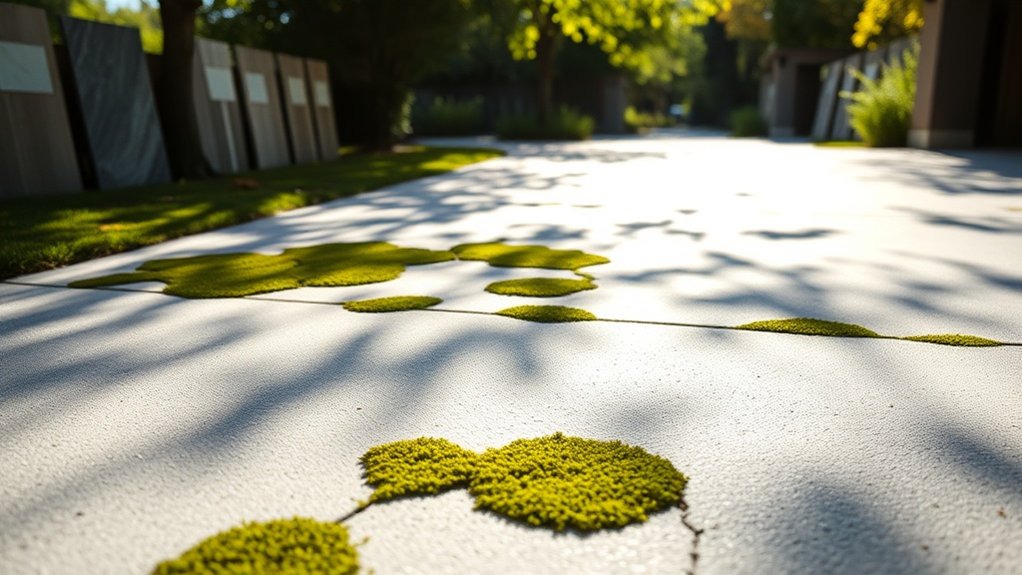
As the demand for sustainable building materials increases, innovations in low-carbon concrete are becoming more important.
For instance, supplementary cementitious materials (SCMs) like fly ash and slag can reduce carbon emissions by 20-30%. On the other hand, limestone calcined clay cement (LC3) can achieve a remarkable 40% reduction, potentially saving 500 million tonnes of CO2 each year by 2030.
New materials and refined concrete mix designs improve curing efficiency, which lowers cement usage while preserving strength.
Advanced chemical admixtures enhance workability and speed up strength development, making low-carbon options practical.
Additionally, emerging technologies like algae-based bio-cement and electric-powered recycled cement production further aid in cutting carbon emissions.
These developments indicate a significant shift in the concrete industry towards more sustainable practices.
Balancing Durability and Sustainability in Driveway Choices
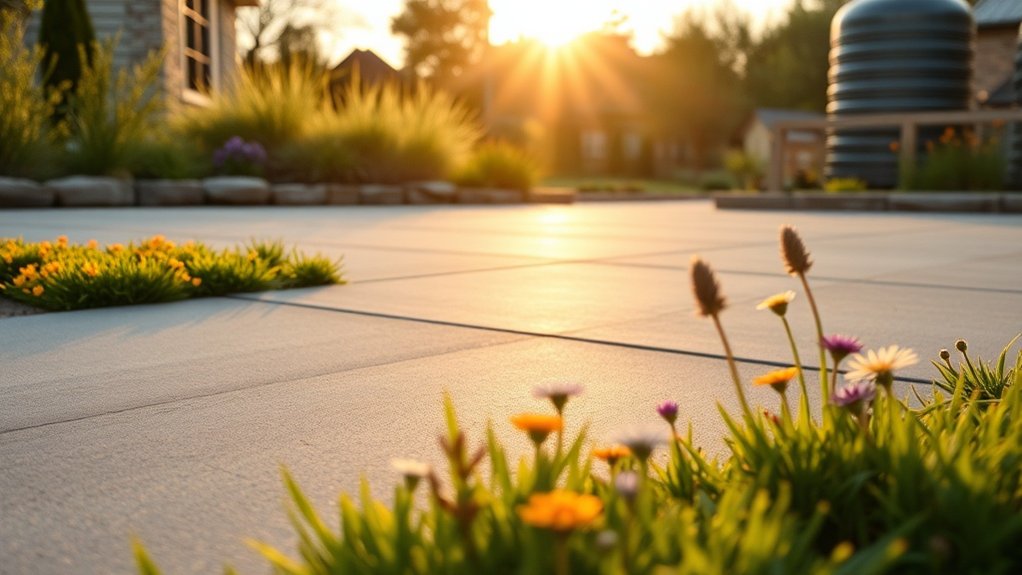
Choosing the right driveway material involves balancing durability with sustainability, as both factors significantly affect long-term performance and environmental impact.
Concrete driveways are known for their longevity, often lasting over 30 years with proper maintenance. However, the production of cement is a major contributor to CO2 emissions, raising sustainability concerns.
Here are some key points to consider:
- Look into sustainable options, such as concrete with recycled content, to lessen the demand for new resources.
- Consider eco-friendly alternatives like permeable pavers, which help manage water runoff effectively.
- Durable materials require less maintenance, which can reduce emissions associated with repairs.
- Keep in mind that concrete’s thermal properties can help lower energy consumption, adding to its sustainability.
Frequently Asked Questions
Can Concrete Driveways Improve Property Value and Aesthetics?
Concrete driveways can significantly improve property value and aesthetics. By complementing modern design trends and enhancing curb appeal, they attract potential buyers and create a lasting impression that increases overall desirability. For instance, a well-laid concrete driveway can make a home stand out in a competitive market, making it more appealing to prospective buyers.
How Do Concrete Driveways Affect Local Wildlife Habitats?
Concrete driveways can fragment habitats, isolating wildlife and disrupting their movements. For instance, hedgehogs and frogs often struggle to cross these surfaces, which can lead to increased mortality rates. This disruption hampers the establishment of wildlife corridors, ultimately harming local ecosystems and reducing biodiversity.
What Maintenance Practices Can Enhance a Concrete Driveway’s Sustainability?
To improve the sustainability of your concrete driveway, consider using eco-friendly sealants and choosing permeable surfaces. Regular maintenance, such as promptly sealing cracks and incorporating plants or greenery, can further enhance its environmental benefits and lifespan.
Are There Health Risks Associated With Concrete Dust Exposure?
Yes, exposure to concrete dust poses health risks, such as respiratory problems like chronic bronchitis and even lung cancer. Inhaling it over a long period can lead to serious health issues, so it’s essential to take protective measures, especially in workplaces where dust is prevalent. For example, wearing masks and using proper ventilation can help reduce these risks significantly.
How Does Climate Impact the Performance of Concrete Driveways?
How do temperature changes and rainfall patterns affect the performance of your concrete driveway? Extreme temperatures can cause cracking, while poor drainage from heavy rain can lead to increased moisture exposure, which undermines durability and shortens its lifespan. For instance, if water pools on your driveway after a downpour, it can seep into cracks, causing further damage when temperatures drop.
Conclusion
When considering the eco-friendliness of a concrete driveway, it’s important to balance its durability with its environmental impact. Traditional concrete is long-lasting, but it also contributes significantly to carbon emissions and urban heat. Why not explore more sustainable alternatives that offer both practicality and eco-consciousness? Options like permeable paving and low-carbon materials not only enhance your property’s appearance but also reduce your carbon footprint. Making informed choices today can lead to a more sustainable future.
Wondering if a resin driveway is permeable? Discover why it's an eco-friendly choice that benefits both your home and the Read more
Get the scoop on the best eco-friendly driveway sealing options that protect your surface and the environment—discover which one is Read more
Sustainable alternatives to concrete driveways exist, but their environmental impact raises questions that demand deeper exploration. What are these alternatives?

